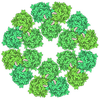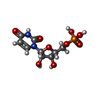+ Open data
Open data
- Basic information
Basic information
| Entry | Database: PDB / ID: 5mup | |||||||||
|---|---|---|---|---|---|---|---|---|---|---|
| Title | Structure of deformed wing virus, a honeybee pathogen | |||||||||
 Components Components |
| |||||||||
 Keywords Keywords | VIRAL PROTEIN / Deformed wing virus / Picornavirales / Iflaviridae / Iflavirus / bee pathogen | |||||||||
| Function / homology |  Function and homology information Function and homology informationviral capsid / RNA helicase activity / cysteine-type endopeptidase activity / viral RNA genome replication / RNA-directed RNA polymerase activity / DNA-templated transcription / structural molecule activity / proteolysis / RNA binding / ATP binding Similarity search - Function | |||||||||
| Biological species |   Deformed wing virus Deformed wing virus | |||||||||
| Method | ELECTRON MICROSCOPY / single particle reconstruction / cryo EM / Resolution: 3.8 Å | |||||||||
 Authors Authors | Skubnik, K. / Novacek, J. / Fuzik, T. / Pridal, A. / Paxton, R. / Plevka, P. | |||||||||
| Funding support | 2items
| |||||||||
 Citation Citation |  Journal: Proc Natl Acad Sci U S A / Year: 2017 Journal: Proc Natl Acad Sci U S A / Year: 2017Title: Structure of deformed wing virus, a major honey bee pathogen. Authors: Karel Škubník / Jiří Nováček / Tibor Füzik / Antonín Přidal / Robert J Paxton / Pavel Plevka /   Abstract: The worldwide population of western honey bees () is under pressure from habitat loss, environmental stress, and pathogens, particularly viruses that cause lethal epidemics. Deformed wing virus (DWV) ...The worldwide population of western honey bees () is under pressure from habitat loss, environmental stress, and pathogens, particularly viruses that cause lethal epidemics. Deformed wing virus (DWV) from the family , together with its vector, the mite , is likely the major threat to the world's honey bees. However, lack of knowledge of the atomic structures of iflaviruses has hindered the development of effective treatments against them. Here, we present the virion structures of DWV determined to a resolution of 3.1 Å using cryo-electron microscopy and 3.8 Å by X-ray crystallography. The C-terminal extension of capsid protein VP3 folds into a globular protruding (P) domain, exposed on the virion surface. The P domain contains an Asp-His-Ser catalytic triad that is, together with five residues that are spatially close, conserved among iflaviruses. These residues may participate in receptor binding or provide the protease, lipase, or esterase activity required for entry of the virus into a host cell. Furthermore, nucleotides of the DWV RNA genome interact with VP3 subunits. The capsid protein residues involved in the RNA binding are conserved among honey bee iflaviruses, suggesting a putative role of the genome in stabilizing the virion or facilitating capsid assembly. Identifying the RNA-binding and putative catalytic sites within the DWV virion structure enables future analyses of how DWV and other iflaviruses infect insect cells and also opens up possibilities for the development of antiviral treatments. | |||||||||
| History |
|
- Structure visualization
Structure visualization
| Movie |
 Movie viewer Movie viewer |
|---|---|
| Structure viewer | Molecule:  Molmil Molmil Jmol/JSmol Jmol/JSmol |
- Downloads & links
Downloads & links
- Download
Download
| PDBx/mmCIF format |  5mup.cif.gz 5mup.cif.gz | 163.7 KB | Display |  PDBx/mmCIF format PDBx/mmCIF format |
|---|---|---|---|---|
| PDB format |  pdb5mup.ent.gz pdb5mup.ent.gz | 127.2 KB | Display |  PDB format PDB format |
| PDBx/mmJSON format |  5mup.json.gz 5mup.json.gz | Tree view |  PDBx/mmJSON format PDBx/mmJSON format | |
| Others |  Other downloads Other downloads |
-Validation report
| Summary document |  5mup_validation.pdf.gz 5mup_validation.pdf.gz | 810 KB | Display |  wwPDB validaton report wwPDB validaton report |
|---|---|---|---|---|
| Full document |  5mup_full_validation.pdf.gz 5mup_full_validation.pdf.gz | 820.2 KB | Display | |
| Data in XML |  5mup_validation.xml.gz 5mup_validation.xml.gz | 40.3 KB | Display | |
| Data in CIF |  5mup_validation.cif.gz 5mup_validation.cif.gz | 59.9 KB | Display | |
| Arichive directory |  https://data.pdbj.org/pub/pdb/validation_reports/mu/5mup https://data.pdbj.org/pub/pdb/validation_reports/mu/5mup ftp://data.pdbj.org/pub/pdb/validation_reports/mu/5mup ftp://data.pdbj.org/pub/pdb/validation_reports/mu/5mup | HTTPS FTP |
-Related structure data
| Related structure data |  3570MC  3574C  3575C  4009C  4014C 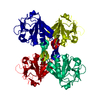 5g51C 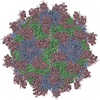 5g52C  5l7qC  5l8qC  5mv5C  5mv6C M: map data used to model this data C: citing same article ( |
|---|---|
| Similar structure data |
- Links
Links
- Assembly
Assembly
| Deposited unit | 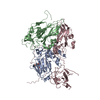
|
|---|---|
| 1 | x 60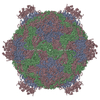
|
| 2 |
|
| 3 | x 5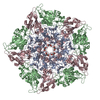
|
| 4 | x 6
|
| 5 | 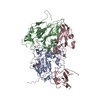
|
| Symmetry | Point symmetry: (Schoenflies symbol: I (icosahedral)) |
- Components
Components
| #1: Protein | Mass: 28679.273 Da / Num. of mol.: 1 / Source method: isolated from a natural source / Source: (natural)   Deformed wing virus / References: UniProt: L0CTV4 Deformed wing virus / References: UniProt: L0CTV4 |
|---|---|
| #2: Protein | Mass: 28360.900 Da / Num. of mol.: 1 / Source method: isolated from a natural source / Source: (natural)   Deformed wing virus / References: UniProt: E0YTW0, UniProt: Q7TG18*PLUS Deformed wing virus / References: UniProt: E0YTW0, UniProt: Q7TG18*PLUS |
| #3: Protein | Mass: 46697.582 Da / Num. of mol.: 1 / Source method: isolated from a natural source / Source: (natural)   Deformed wing virus / References: UniProt: Q7TG18 Deformed wing virus / References: UniProt: Q7TG18 |
| #4: Chemical | ChemComp-U5P / |
-Experimental details
-Experiment
| Experiment | Method: ELECTRON MICROSCOPY |
|---|---|
| EM experiment | Aggregation state: PARTICLE / 3D reconstruction method: single particle reconstruction |
- Sample preparation
Sample preparation
| Component | Name: Deformed wing virus / Type: VIRUS / Details: Virus was purified from honeybee pupae / Entity ID: #1-#3 / Source: NATURAL |
|---|---|
| Molecular weight | Experimental value: NO |
| Source (natural) | Organism:   Deformed wing virus Deformed wing virus |
| Details of virus | Empty: NO / Enveloped: NO / Isolate: OTHER / Type: VIRION |
| Natural host | Organism: Apis mellifera |
| Virus shell | Diameter: 390 nm / Triangulation number (T number): 3 |
| Buffer solution | pH: 7.4 Details: Dulbeccos Phosphate Buffered Saline D8537 sigma aldrich |
| Specimen | Conc.: 2.5 mg/ml / Embedding applied: NO / Shadowing applied: NO / Staining applied: NO / Vitrification applied: YES Details: Virus was incubated in high salt solution containing 0.8 M potassium dihydrogen phosphate, 0.8 M sodium dihydrogen phosphate, 0.1 M sodium HEPES, pH 7.5. After 12 hours incubation was virus ...Details: Virus was incubated in high salt solution containing 0.8 M potassium dihydrogen phosphate, 0.8 M sodium dihydrogen phosphate, 0.1 M sodium HEPES, pH 7.5. After 12 hours incubation was virus dialysed into PBS buffer. |
| Specimen support | Grid material: COPPER / Grid mesh size: 300 divisions/in. / Grid type: Quantifoil R2/1 |
| Vitrification | Instrument: FEI VITROBOT MARK IV / Cryogen name: ETHANE / Humidity: 100 % / Chamber temperature: 298 K |
- Electron microscopy imaging
Electron microscopy imaging
| Experimental equipment |  Model: Titan Krios / Image courtesy: FEI Company |
|---|---|
| Microscopy | Model: FEI TITAN KRIOS |
| Electron gun | Electron source:  FIELD EMISSION GUN / Accelerating voltage: 300 kV / Illumination mode: FLOOD BEAM FIELD EMISSION GUN / Accelerating voltage: 300 kV / Illumination mode: FLOOD BEAM |
| Electron lens | Mode: BRIGHT FIELD / Nominal magnification: 75000 X / Calibrated magnification: 74235 X / Nominal defocus max: 4000 nm / Nominal defocus min: 1000 nm / Cs: 2.7 mm / C2 aperture diameter: 100 µm / Alignment procedure: COMA FREE |
| Specimen holder | Cryogen: NITROGEN / Specimen holder model: FEI TITAN KRIOS AUTOGRID HOLDER |
| Image recording | Average exposure time: 1 sec. / Electron dose: 21 e/Å2 / Detector mode: COUNTING / Film or detector model: FEI FALCON II (4k x 4k) / Num. of grids imaged: 1 |
| Image scans | Width: 4096 / Height: 4096 / Movie frames/image: 16 / Used frames/image: 2-16 |
- Processing
Processing
| EM software |
| |||||||||||||||||||||||||||||||||||||||||||||
|---|---|---|---|---|---|---|---|---|---|---|---|---|---|---|---|---|---|---|---|---|---|---|---|---|---|---|---|---|---|---|---|---|---|---|---|---|---|---|---|---|---|---|---|---|---|---|
| CTF correction | Type: PHASE FLIPPING AND AMPLITUDE CORRECTION | |||||||||||||||||||||||||||||||||||||||||||||
| Particle selection | Num. of particles selected: 3918 | |||||||||||||||||||||||||||||||||||||||||||||
| 3D reconstruction | Resolution: 3.8 Å / Resolution method: FSC 0.143 CUT-OFF / Num. of particles: 879 / Algorithm: FOURIER SPACE / Num. of class averages: 1 / Symmetry type: POINT | |||||||||||||||||||||||||||||||||||||||||||||
| Atomic model building | Protocol: OTHER / Space: REAL / Target criteria: R-factor |
 Movie
Movie Controller
Controller



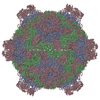

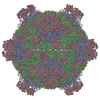
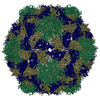
 PDBj
PDBj
